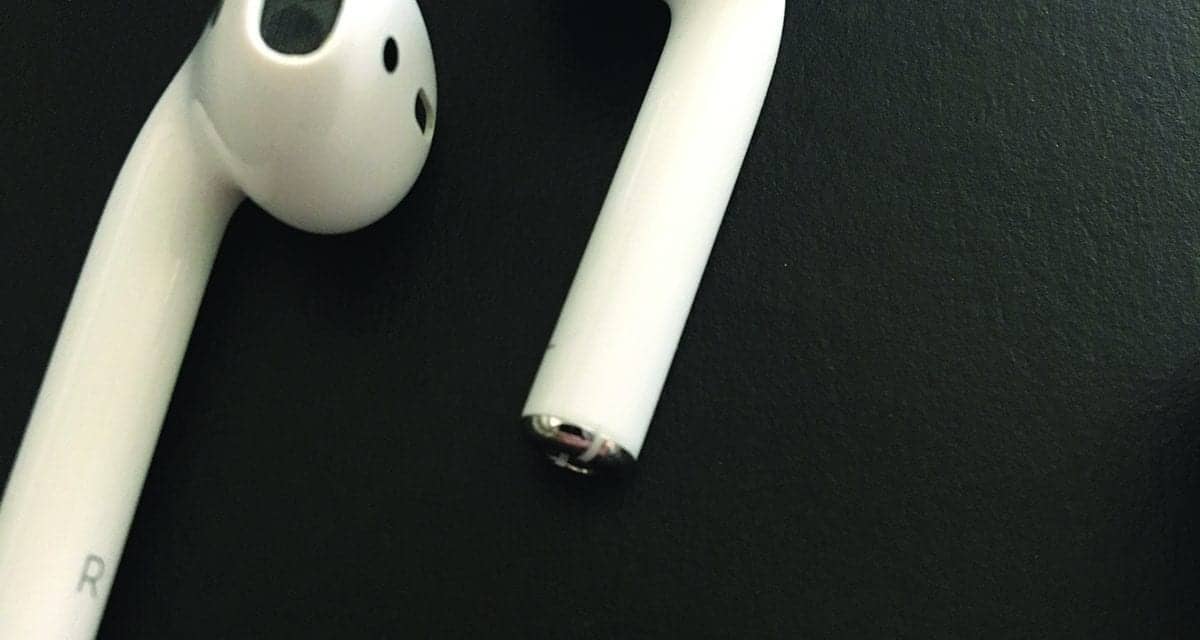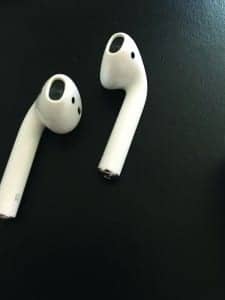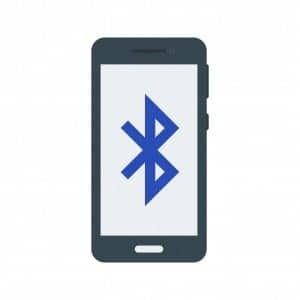Tech Topic | October 2017 Hearing Review
The short answer: No, but the situation is complex. As this article explains, the key problem with the wireless Bluetooth protocol is latency—or the amount of time it takes to capture, process, amplify, and convey the signals wirelessly to the earbuds. AirPods and other Bluetooth earbuds that are not already designed for live listening (as hearing aids and PSAPs are) cannot presently leverage Bluetooth for live hearing assistance. By contrast, wired earbuds can be used with mobile phone apps for live conversations and as listening assistance devices.
In late 2016, Apple began selling their long-awaited AirPods ($159). These elegantly designed earbuds wirelessly stream audio from smartphones, computers, and other devices via the standard Bluetooth (BT) protocol. Using AirPods with their smartphones, consumers can make hands-free phone calls as well as enjoy other kinds of audio—all without a wired physical connection. The AirPods were an immediate hit, and more than 7 months later, the demand for AirPods continued to exceed their supply.1
While a textbook example of a great consumer audio product, AirPods were not intended to be used as hearing aids. However, some companies that make iOS hearing apps have strongly implied in their marketing that AirPods can, in fact, be configured through their apps as hearing aids practical for live listening. Is that actually possible?
According to extensive testing by the hearing technology company Jacoti BVBA (jacoti.com), the answer is “no.” The major problem is that the standard Bluetooth protocol used by AirPods creates an unacceptable amount of delay in the signal. Among other issues, this creates a disturbing loss of audio-visual synchronization that adversely affects speech reading. Until there is a faster Bluetooth protocol or Apple and similar companies implement a different and faster wireless audio solution, AirPods and wireless earbuds are simply not practical for live listening assistance.
This problem is well known among developers. When the AirPods became available late last year, Jacoti ran tests and determined that, due to excessive Bluetooth delay, AirPods could not be used for effective hearing assistance with their—or anyone else’s—products.
This can get confusing. Don’t made-for-iPhone (MFi) hearing aids, as well as many personal sound amplification products (PSAPs) and hearables, use Bluetooth? Yes, they do, but not for live audio streaming (with one exception discussed below). In these devices, Bluetooth functionality simply adds features such as the ability to remotely adjust the hearing device’s volume; to change presets from a smartphone; to make and receive phone calls wirelessly; and to wirelessly stream music and other audio directly into the hearing aid or PSAP. The capability of these devices to provide effective live audio streaming (for example, when having a conversation in the same room with someone) has nothing to do with Bluetooth. It is achieved via the implementation of standard hearing aid design and manufacture. The exception: for MFi hearing aids, Apple custom modified the Bluetooth LE protocol to shorten the delay for audio transmission. This enables an iPhone to be used as a remote mic, but only with MFi hearing aids—not with any consumer devices, including the AirPods.
It should also be noted that some in-ear devices with Bluetooth can be used for hearing assistance for people with normal hearing or those with relatively moderate hearing issues. PSAPs like the Nuheara IQbuds, Sound World Solutions’ products, the Bragi Dash, and the Doppler Here One utilize Bluetooth—but not for live listening. For live listening they use the more standard hearing aid/PSAP onboard processing and amplification.
What about Bluetooth streamers? In fact, these devices typically use two or more different types of wireless transmission. As always, the Bluetooth protocol is used only for tasks that are less time-critical than live streaming (phone calls, music streaming, etc). In order to couple the streamer to hearing aids, a second wireless transmission method (such as near-field magnetic induction [NFMI]) is used. And when a remote mic is included as part of a streamer package, either a third wireless transmission method is deployed to minimize the delay (such as FM) or the Bluetooth protocol is customized.
Latency and Hearing Aids
Hearing aids take time to capture, process, and amplify live sound. As a result, a hearing aid’s acoustic output is slightly delayed relative to the original live sound. The difference between the time of the original sound and the time when the amplified sound leaves the hearing aid is called “latency.”
Small latencies are unnoticeable or tolerable. But if the latency is more than 40 ms, “auditory information may fall out of synchronization with the visual information and interfere with speech reading.” Taking this and other problems into account, modern hearing aids typically have a total system latency of much less than 40 ms—even as low as 10 ms.2,3
All wireless transmission schemes add additional latency to the audio signal path. In the case of Bluetooth, that latency can easily be 60-80 ms or more, depending upon the way the BT protocol is implemented on a specific device. In AirPods, the combined system latency (audio signal processing plus Bluetooth transmission) creates very audible and disturbing delays between the live and amplified sound.
Testing an iPhone Hearing App
Jacoti recently tested an app for the iPhone whose marketing suggested that it could be successfully used with AirPods for live hearing assistance. For that to be true, the total latency of a wireless AirPod-based hearing system would have to be 40 ms or under.
The app enables the user to select either a mic on the AirPods or one of the two mics on the iPhone for wireless transmission to the AirPods. Jacoti tested all three conditions.
The results:
- Latency with wireless Apple AirPods via onboard mic: 192 ms
- Latency with wireless Apple AirPods and iPhone mic 1 (“1-person” mode): 295 ms
- Latency with wireless Apple AirPods and iPhone mic 2 (”Group” mode): 258 ms
To summarize, Jacoti found latencies using AirPods to be approximately 5 to 7 times greater than the maximum acceptable amount for live listening. Even in Jacoti’s own ListenApp, Jacoti found 266 ms of latency when using AirPods. High latency is simply inherent to the current Bluetooth protocol.
Conclusion
Apple’s AirPods and similar Bluetooth earbuds are impractical for wireless live hearing assistance via apps on mobile phones. There is too much latency. People attempting to listen to live speech over these devices will perceive a speaker’s lips substantially out of sync with the speaker’s voice. In addition, the users of BT earbuds will hear a distracting echo of their own voice. At present, Bluetooth can only be used to add remote convenience features (such as volume control) to hearing aids and PSAPs with conventional on-device amplification and signal processing.
There are ways to get lower wireless latency through the use of the low latency aptX codec (aptx.com). However, Apple has yet to implement aptX, and even if they did, it is unclear whether the total system latency would still be low enough for effective live hearing assistance. Similarly, while hearing aid companies and Bluetooth have been collaborating on a new low-latency iteration of the Bluetooth protocol,4 it is likely several years away from completion.
By contrast, the minimal amount of latency inherent to wired earphones indeed makes possible the use of apps for live listening assistance. For example, Jacoti measured 16 ms of latency using Jacoti’s ListenApp hearing application and the mic on Apple’s wired Lightning EarPods. As Amlani et al5 have pointed out, app-based listening assistance can be effective.
Finally, technology changes rapidly, and given the recent legislative changes that will permit the sale of over-the-counter (OTC) hearing aids, Apple and other companies may very well be working on an AirPod-like device that can be used for live hearing assistance. But, at least at present (and likely for some time), hearing care professionals can feel confident informing their patients that AirPods and similar BT earbuds which are not set up for on-device amplification are no substitute for hearing aids! ?
Acknowledgements
The author is a consultant for Jacoti and wishes to thank the software development team at the company for their data and help in writing this article.
Correspondence can be addressed to Richard Einhorn at: [email protected]
Citation for this article: Einhorn R. Can Apple AirPods be used as hearing aids? Hearing Review. 2017;24(10):24-25.
References
-
Somaney J. Apple watch sales looking up and Apple AirPod demand still continues to easily outpace supply. July 10, 2017. Available at: https://www.forbes.com/sites/jaysomaney/2017/07/10/apple-watch-and-apple-airpod-demand-continues-to-easily-outpace/#38deaae712b9, July 10, 2017.
-
Herbig R, Chalupper J. Acceptable processing delay in digital hearing aids. Hearing Review. 2010;17(1):28-31. Available at: https://hearingreview.com/2010/01/acceptable-processing-delay-in-digital-hearing-aids/
-
Burwinkel JR, McKinney M, Galster J. Acceptable Hearing Aid Throughput Delay For Listeners with Hearing Loss Under Noisy Conditions. [Poster.] Eden Prairie, Minn: Starkey Hearing Technologies. Available at: http://hearinghealthmatters.org/journalresearchposters/files/2016/03/AAS_Latency.pdf
-
Bluetooth SIG and EHIMA Partner to Advance Hearing Instrument Technology. March 21, 2014. Available at: https://hearingreview.com/2014/03/bluetooth-sig-ehima-partner-advance-hearing-instrument-technology/
-
Amlani AM, Taylor B, Levy C, Robbins R. Utility of smartphone-based hearing aid applications as a substitute to traditional hearing aids. Hearing Review. 2013. 20(12)[Dec]: 16-23. Available at: https://hearingreview.com/2014/01/utility-of-smartphone-based-hearing-aid-applications-as-a-substitute-to-traditional-hearing-aids/









I struggle with my hearing everyday. I found that when I go to a Catholic church, many have what is called “The Loop” and I can hear very, very well wearing the same hearing aid that gives me grief in other locations. What is it that allows this “loop” to broadcast crystal clear speech and can this system be converted to everyday use?
Thank You,
Joe Maniec
Three quick comments:
1) The GN ReSound Unite system (which Cochlear licenses) and Phonak Roger system both use Bluetooth 4/Low Energy (“BLE”) stacks with proprietary low-latency codecs;
2) When latency exceeds 40 mSec, you get audible feedforward comb filter distortion if any of the ambient sound is also present; but this would not occur with sealed earmolds;
3) Apple iPhones are designed with mics to pick up close-in speech, as they are telephones. Their “Live Listen” function is all-but useless unless the user holds it within about a foot of the speaker.
Catching up on my reading….good job. The airpods I tried just kind of floatedd in my ears, falling out whenever I made a sudden move. But maybe it’s just me.
In my opinion apple will move forward and includes hearing aids/sound amplifier/ listening devices more and more in their portfolio and soon they will offer them.
You can see this trend already in the past years, started with the iWatch, it tracks your metrics and you can see how many calories you burned.
Apple’s innovation spirit for technical products is lost, their “innovation” for the iPhone X is an edge-to-edge display – Samsung had it 5 months ago and they even buy in the displays from Samsung.
But apple will earn the big money with the health care products, they added more and more products in their portfolio (https://www.apple.com/healthcare).
Apple was the first smartphone manufacture which integrated hearing aids under accessibility, with iOS 11 the additional apps from the hearing aid manufactures are needless.
Greetings, Michel
Thank you for this well researched and most articulate article. Richard, you have given us a remarkable resource!